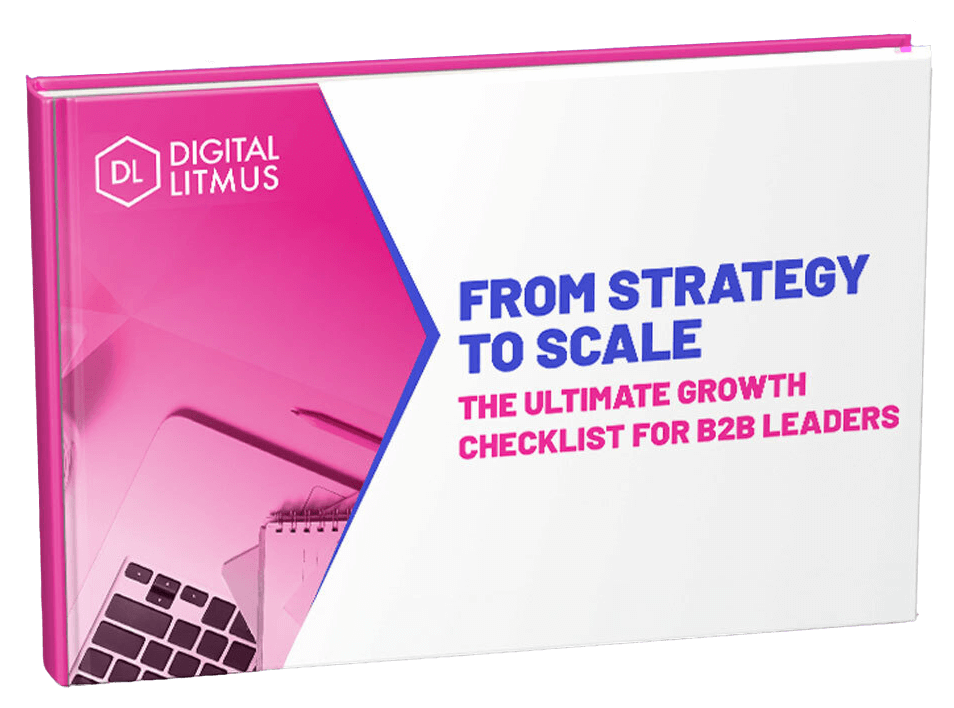B2B companies love talking about growth. But here's the hard truth: growth without efficiency isn't just unsustainable - it's expensive chaos.
When your revenue engine is misaligned, the symptoms are painfully familiar: Marketing generates leads that sales ignores. Sales teams waste hours on manual processes instead of closing deals. Customer success scrambles to reduce churn rather than driving expansion revenue. And executives can't get reliable forecasts to make strategic decisions.
The old playbook: Department silos. Conflicting KPIs. Data fragmented across disconnected tools. Manual handoffs that drop potential revenue at every turn.
The new playbook: Revenue Operations (RevOps) - the strategic alignment of marketing, sales, and customer success into one cohesive, data-driven revenue machine.
This shift isn't just theoretical. The data tells a compelling story:
- 75% of the world's highest-growth companies have already implemented RevOps functions (Gartner)
- Businesses with aligned revenue teams achieve 20%+ higher sales productivity (Boston Consulting Group)
- Companies with mature RevOps see up to 300% acceleration in revenue growth (Forrester)
- Organisations with connected tech stacks report a 209% increase in marketing-sourced revenue (HubSpot)
What You'll Learn In This Guide
✅ What RevOps really means beyond the buzzword and why it matters for growing B2B companies
✅ The four essential pillars that make RevOps work: alignment, process, technology, and intelligence
✅ Common obstacles to implementing RevOps and practical ways to overcome them
✅ Emerging trends shaping the future of revenue operations
✅ Actionable steps to kickstart your RevOps journey with measurable results
At Digital Litmus, we've helped B2B companies transform their revenue operations from fragmented to unified, with measurable improvements in efficiency and growth. Let's explore how you can achieve similar results.
What is Revenue Operations (RevOps)? Beyond the Buzzword
Revenue Operations isn't just another business acronym or a fancy new dashboard, it's a fundamental shift in how B2B companies approach growth.
At its core, RevOps breaks down the traditional barriers between revenue-generating teams, replacing departmental silos with an integrated system that optimises the entire customer journey, from first touch to renewal and expansion.
The Evolution of RevOps
The concept didn't emerge overnight. As B2B sales cycles grew more complex and buyer journeys more digital, companies realised that the traditional model of separate operations teams (sales ops, marketing ops, customer success ops) created more problems than it solved:
- 2010-2015: Early adopters began integrating sales and marketing operations
- 2016-2019: The term "Revenue Operations" gained traction as customer success became equally critical to revenue growth
- 2020-Present: RevOps has evolved from a trend to a competitive necessity for growing companies, accelerated by digital transformation
What RevOps Actually Does
🔄 Aligns Strategy: Creates a unified approach to revenue generation across all customer-facing teams
🔧 Removes Friction: Identifies and eliminates bottlenecks in the customer journey
📊 Drives Efficiency: Optimises processes, resources, and technology to maximise revenue per employee - critical for resource-constrained SMEs
🔍 Enables Data-Driven Decisions: Establishes a single source of truth for revenue data and performance metrics
The Reality of Business Without RevOps
Consider a typical scenario we've seen repeatedly:
A B2B software company was hitting its growth targets but at unsustainable costs. Marketing celebrated MQL numbers without feedback from sales about poor lead quality. Sales complained about leads while drowning in administrative tasks that prevented proper qualification. Customer success struggled with onboarding clients, using manual processes that slowed everything down. The disconnected systems created a perfect storm: rising marketing costs, an inefficient sales team and poorly onboarded customers leading to dissatisfaction and increased churn.
This is the reality for companies without RevOps. They can grow, but with diminishing returns and increasing complexity. The disconnection between teams creates a leaky revenue bucket that no amount of new leads can fill.
The companies winning today? They've made RevOps the foundation of their growth strategy, not an afterthought.
The Essential Pillars of Effective RevOps
Implementing RevOps isn't about simply adding a new job title or purchasing another software solution. It requires building a systematic framework that supports sustainable, predictable revenue growth.
Here are the four essential pillars that every successful RevOps implementation must address:
Strategic Alignment: Getting Everyone on the Same Page
When each department marches to the beat of its own drum, your revenue engine sputters. Your marketing team pushes to show activity metrics while the sales team focuses solely on closed deals, and your customer success team scrambles to retain customers who weren't properly qualified from the start.
What effective alignment looks like:
- Unified Revenue Goals: Replace siloed metrics with shared objectives that matter - pipeline velocity, conversion rates, and customer lifetime value
- Clear Ownership with No Gaps: Explicitly defined responsibilities across the entire customer journey, eliminating the "not my job" syndrome
- Shared Data Model: A consistent underlying data architecture that ensures all teams are working from the same definitions, hierarchies, and relationships - creating a truly unified view of customers and opportunities
- Consistent Revenue Language: A standardised definition of terms like "Marketing Qualified Lead," "Opportunity," and "Customer Health" that all teams understand and use
- Joint Planning Processes: Collaborative forecasting and resource allocation based on shared revenue targets
Mid-market companies with tightly aligned revenue teams report 36% higher customer retention rates and 38% more closed deals, according to Forrester.
2. Process Excellence: Eliminating Revenue Leakage
Even the most brilliant strategy collapses under the weight of chaotic execution. For many growing B2B companies, inconsistent processes create a maze where leads, opportunities, and customers get lost.
Key process areas to optimise:
- Lead Management Framework: Clear criteria for lead scoring, routing, and handoffs between marketing and sales
- Opportunity Management: Standardised sales stages with exit criteria that reflect the actual buyer journey
- Customer Lifecycle Management: Seamless transitions from prospect to customer with clear handoffs from sales to customer success
- Renewal and Expansion Processes: Proactive systems to identify growth opportunities within existing accounts
Mid-market companies with documented sales processes see 18% higher revenue growth according to Harvard Business Review.
3. Technology Integration: From Tech Stack to Revenue Engine
For growing B2B companies, technology challenges often stem not from having too many tools, but from having the wrong mix of disconnected solutions. It's not uncommon to see mature B2B companies using as many as 10 - 20 different sales, marketing and customer service tools, none of which were designed to work together seamlessly. The result? Patchy data, manual workarounds, and decisions based on incomplete information.
Building an integrated tech stack:
- CRM as the Single Source of Truth: Platforms like HubSpot become the central nervous system where all customer data lives
- Strategic Tool Selection: Evaluating your tech stack based on integration capabilities and scalability, not just immediate needs
- Automation that Actually Works: End-to-end workflows that eliminate manual data entry and automate repetitive tasks
- Build a Quality Database: Clear protocols for data hygiene, enrichment, and management that grow with your business
By consolidating their Marketing tech stack and implementing HubSpot as their central platform across 10 of their brands, Supporting Education Group, saw huge cost efficiencies, lead growth and measurable impact on Customer Lifetime Value. Read the case study
4. Revenue Intelligence: Transforming Data into Growth Decisions
Despite having more data than ever, many growing B2B companies struggle to extract actionable insights. Want to stop your teams making crucial decisions based on gut feeling rather than evidence? Then this is an area to get on top of.
Components of effective revenue intelligence:
- Unified Dashboards: Real-time visibility into the health of your revenue pipeline
- Leading Indicators: Early warning systems that predict revenue outcomes before they happen
- Customer Insights: Deep understanding of buying patterns, engagement signals, and churn risks
- Scenario Planning: The ability to model different growth strategies and their likely outcomes
Mid-market companies leveraging advanced analytics are 5x more likely to make faster decisions and 2x more likely to achieve top-quartile financial performance in their sector. (McKinsey)
The Multiplier Effect: When All Four Pillars Work Together
Whilst each pillar delivers value independently, the true power of RevOps emerges when all four work in a connected manner. This creates a multiplier effect where:
- Strategic alignment ensures everyone pulls in the same direction
- Process excellence eliminates friction and accelerates deals
- Technology integration provides the infrastructure for scale
- Revenue intelligence guides continuous optimisation
Growing organisations that master all four pillars don't just grow incrementally, they create compounding advantages that dramatically outpace their competitors.
Common Roadblocks to RevOps Success
Even when growing companies recognise the need for RevOps, implementation often hits significant obstacles. These challenges are rarely purely technical. They're typically rooted in organisational dynamics, legacy systems, and resistance to change.
Let's examine the most common roadblocks and how to overcome them:
Entrenched Departmental Silos
The challenge: In SMEs, marketing, sales, and customer success often operate as separate teams, each with their own priorities and metrics, even when they sit just a few desks away from each other. Breaking down these walls requires more than just reorganising roles.
Telltale symptoms
- "That's not our problem" mentality between departments
- Finger-pointing when revenue targets are missed
- Duplicate or contradictory customer data across teams
- Conflicting messages delivered to customers at different journey stages
How to conquer it 💪
Start with shared metrics and joint accountability. True alignment happens when both teams share ownership of the entire revenue process:
- Marketing is measured not just on lead volume but on qualified opportunities that convert to revenue
- Sales is measured not just on closed deals but also on effectively working the leads marketing provides
Both teams are jointly accountable for conversion rates across the entire funnel.
The Data Quality Crisis
The challenge: Without RevOps governance, customer data becomes fragmented, outdated, and unreliable across your CRM and other tools. Reports contradict each other, and leadership loses confidence in the numbers.
Telltale symptoms
- Multiple versions of "the truth" in reports and dashboards
- Manual data reconciliation taking hours each week
- Low CRM adoption due to distrust in the data
- Inability to accurately forecast revenue
How to conquer it 💪
Implement clear data rules and ownership. Start with a focused data cleanup project targeting your highest-value segments. Establish basic data standards - who's responsible for updating what information, how to maintain data quality, and regular cleanup routines. Automate data enrichment where possible, and make data accuracy part of everyone's job.
Executive Scepticism
The challenge: Without C-suite sponsorship, RevOps initiatives often get reduced to technical projects rather than strategic transformations. This is especially challenging in smaller companies where executives wear multiple hats and may view RevOps as a 'nice-to-have' rather than essential infrastructure.
Telltale symptoms
- RevOps initiatives underfunded or staffed with junior resources
- Focus on tactical fixes rather than strategic alignment
- Resistance to process changes that impact executive reporting
- Short-term revenue pressure overriding system improvements
How to conquer it 💪
Frame RevOps in terms of revenue impact and competitive advantage. Build a business case with concrete ROI projections and early wins. Identify an executive champion who can advocate for the initiative at the leadership level and protect it from short-term pressures.
Change Resistance Across Teams
The challenge: People naturally resist changes to how they work, especially when those changes affect how they're measured and rewarded. In SMEs with limited resources, team members may resist new processes they perceive as administrative burden that takes away from core responsibilities.
Telltale symptoms
- Low adoption of new tools and processes
- "Shadow systems" emerging alongside official platforms
- Compliance in meetings but reversion to old habits afterwards
- Teams finding workarounds to avoid cross-departmental collaboration
How to conquer it 💪
Focus on the "what's in it for me" factor for each team. For sales, emphasise how RevOps will help them spend more time selling and less on administration. For marketing, highlight improved attribution and influence metrics. Involve key stakeholders early in the design process, and create a formal change management plan with training, incentives, and clear success metrics.
Resource and Expertise Gaps
The challenge: Many SME organisations lack the specialised skills needed to implement and sustain RevOps initiatives, from systems integration to analytics expertise to process design. Unlike enterprises, they can't afford dedicated RevOps specialists for every function.
Telltale symptoms
- RevOps initiatives that start strong but lose momentum
- Over-reliance on technology vendors for strategic guidance
- Inability to connect technical capabilities to business outcomes
- Constant firefighting rather than strategic improvement
How to conquer it 💪
Be realistic about your internal capabilities and where you need external support. Consider starting with a RevOps assessment from specialists who can identify quick wins and capability gaps. Build a phased approach that balances immediate improvements with long-term capability building.
RevOps transformation isn't about avoiding these challenges, it's about anticipating them and tackling them strategically, even with limited resources.
Seb Hardman, MD - Digital Litmus
5 Practical Steps To KickStart Your RevOps Journey
Ready to move from concept to implementation? Here are 5 practical steps that make a meaningful difference when starting your RevOps journey:
1. Map Your Current Revenue Process
Document your actual customer journey from first touch to renewal. Identify and quantify where leads stall, deals slow down, and customers become at risk. Use data to pinpoint your biggest opportunities for improvement.
2. Build Your Business Case
Calculate what your current inefficiencies are costing in concrete terms: marketing spend on unworked leads, revenue lost to preventable churn, and sales capacity wasted on administrative tasks. Show how RevOps improvements directly impact your bottom line.
3. Establish Your Data Foundation
Commit to your CRM as your central source of truth. Create clear standards for data quality, establish who's responsible for maintaining different data elements, and implement regular clean-up routines. Reliable data is the foundation of effective decision-making.
4. Improve Critical Handoffs
Define exactly what makes a qualified lead, establish clear response time expectations, and create feedback loops between teams. When each team understands how their work affects the next stage, accountability naturally improves.
5. Focus on High-Impact Automation
Identify manual processes that consume significant time without adding value. Target administrative tasks like data entry, follow-up scheduling, and routine reporting. Every hour saved from administrative work translates to more time for revenue-generating activities.
The Future of RevOps Will Change Everything
The RevOps revolution is just getting started, and what's coming next will fundamentally transform how B2B companies grow. The future isn't just promising, it's exhilarating.
AI Will Supercharge Your Revenue Teams
Imagine your sales team knowing exactly which deals to prioritise and which actions will close them. That's not fantasy, it's happening now!
- AI is turning forecasting from educated guesswork into predictive science, with accuracy rates that will make your CFO's jaw drop
- Sales reps are being freed from admin to focus on selling, with AI handling the heavy lifting of data analysis and next-step recommendations
- Customer success teams are identifying potential churn months before it happens, turning problems into opportunities before they even develop
- Revenue leaders are seeing around corners with scenario planning that reveals hidden opportunities your competitors won't spot
The New Era of Authentic Personalisation
The era of superficial "Hi {First Name}" personalisation is coming to an end. We're entering an age where customer interactions will become genuinely tailored, relevant, and end-to-end:
- Personalisation will span the full journey, not just the first few marketing emails
- Real-time behaviour and intent signals will shape outreach, replacing static segments and outdated personas
- AI will optimise every interaction, from timing and tone to channel and content
- Each buying committee member will get bespoke messaging based on their role, objections, and influence
- Consistency across departments will ensure every touchpoint feels joined-up and customer-centric
RevOps will do what siloed teams never could: Unify customer data, unlock AI at scale, and enable every revenue team to respond to buyers with relevance and precision. The result? Better engagement, shorter sales cycles, higher retention and a customer experience that actually feels human.
Technology That Finally Delivers on Its Promise
The tech stack of tomorrow will feel less like wrestling with tools and more like gaining superpowers:
- CRMs are transforming from glorified databases into intelligent assistants that actively guide users to success
- Seamless integration is replacing the duct-tape-and-hope approach of disconnected systems
- Automation is being democratised, giving everyone access to capabilities once reserved for technical specialists
- Data quality is improving through intelligent systems, not mind-numbing manual entry and cleaning
This isn't incremental change, it's a fundamental reinvention of how B2B companies drive growth. The companies that embrace these shifts won't just compete more effectively, they'll operate in an entirely different league.
Final Thoughts - RevOps as Your Growth Engine
The question is no longer whether you need RevOps, it's how quickly you can transform your revenue operations to stay competitive.
B2B SMEs are facing real pressures from multiple directions. Your buyers expect the same seamless purchasing experience they get as consumers. Your competitors are finding ways to sell more efficiently. And economic uncertainty means every pound of marketing and sales spend needs to work harder than ever.
RevOps provides the framework to not just survive these challenges, but to turn them into opportunities for differentiation and growth.
The organisations that will thrive in the next decade are those that recognise RevOps not as a departmental function, but as the operating system for sustainable growth.
Take Your Next Step with a RevOps Assessment
Ready to see how RevOps can transform your business? Digital Litmus offers a comprehensive RevOps Assessment that will:
- Identify the biggest growth opportunities in your current revenue operations
- Highlight process inefficiencies that are costing you revenue
- Assess your technology stack for integration gaps and redundancies
- Provide a prioritised roadmap for RevOps implementation
Book Your Free RevOps Assessment →
In just 30 minutes, we'll show you exactly where RevOps can have the biggest impact on your growth trajectory, and how to get started right away.

Are you a B2B company looking to accelerate growth?
Our connected sales, marketing, and HubSpot agency services might be just the ticket. Get in touch for your free growth assessment to find out how you can accelerate business growth today.





